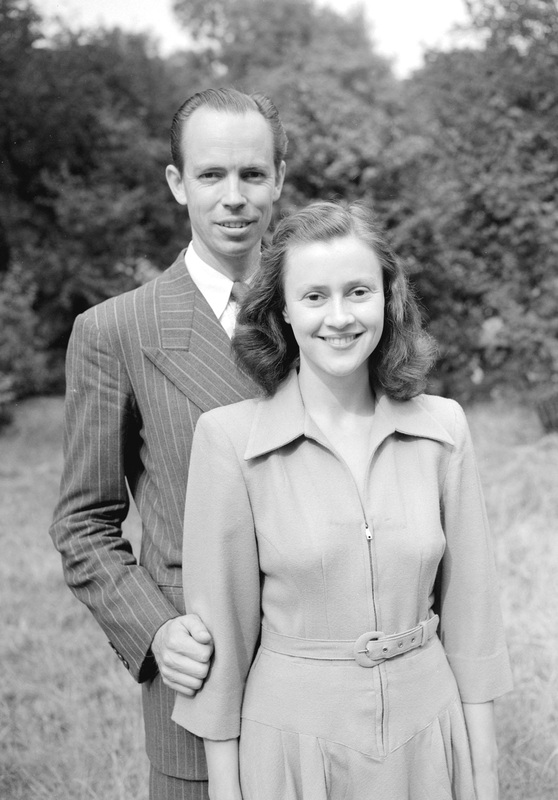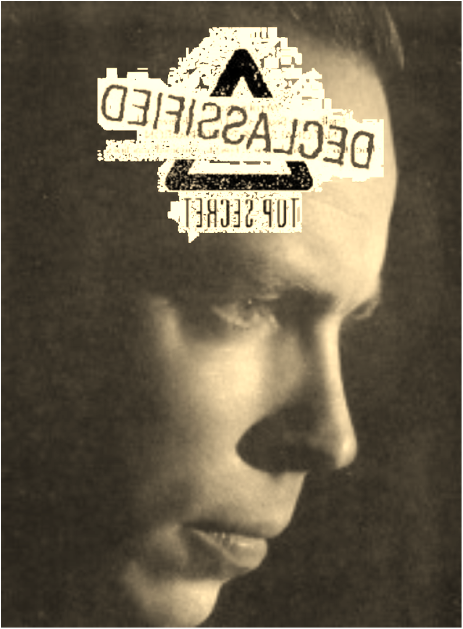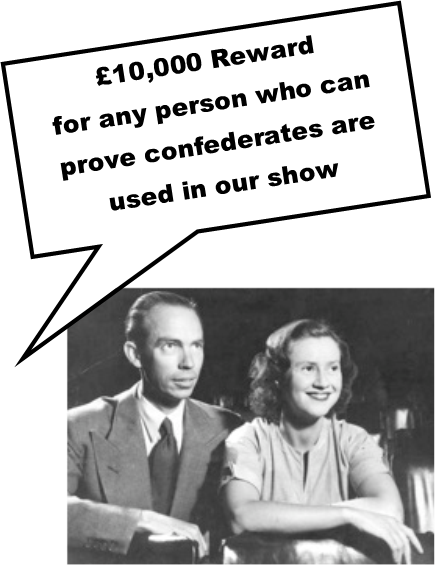Martin T Hart & Tony Griffith discuss the piddingtons
|
1. Martin
My Granddad George Hart worked with the Piddington shows on the BBC here in London and also during their tour of the UK back in 1950. I discovered this by accident whilst working with Paul Daniels in the 1990s and I just had to know more - and over many years I heard all about Piddington's adventures from all who knew. We even found my Granddad's notes about their methods. He had to know of them to do his job in the BBC. Before writing the book I had no idea the methods were unknown, I found this out accidentally. I spoke with the Piddington family and asked permission to pass down the methods to future magicians and they said 'go for it'. The book was born, and wow, what an amazing and wondrous journey it was learning all the unknown secrets and adventures the Piddingtons had. Indeed much has been written about them in the press and I have seen much of it. My book reveals a lot that has never been reported before. I will take you deep behind the scenes. I see this as more than just a book but an 'event' in magic history, the day Piddington's Secrets are finally passed down. James Randi says that it is important to pass the secrets of magic down as they often come back much improved. |
Sydney & Lesley at their London Home
|
|
Declassified Top Secret
3. Martin
Thank you Tony. The broadcasts have been rare for too long, I am glad Jesse Cox agreed to pass the recordings on to me for the site. The book tests were always entertaining. Nowadays, the book test is based on identifying a single word, the Piddingtons transmitted an entire line of text. The audience played their part in randomly choosing a page and line number and I can confirm that the audience members were truly random. The Stratocruiser broadcast has baffled the world. I can confirm the selected envelopes were NOT switched. Penn Jillette also thinks a switch took place. If The Piddingtons could have appeared on Penn & Teller's 'Fool em,' they would have fooled them. You are right about the listener being blind to the goings-on in the BBC studio. However they did have a large studio audience and the Judges were there to represent the eyes of the listener. I can confirm that the Piddingtons did not need to exploit the visual restrictions of radio. They did repeat their demonstrations on Television too, live from Alexandra Palace, although the tapes are now lost. Their theatre shows were an exact copy of what is heard on the radio, they simply repeated the same demonstrations. Russell Braddon was Sydney's closest friend. They suffered the Changi camp together. Interestingly, neither Syd or Russell ever admitted to inventing methods while in the prison camp. To admit this would be admitting the demonstrations were all trickery and that would kill the controversy. So Russell could never be credited for his part in making the tests possible. Your theories about the methods are interesting. A few days ago I was asked if there was a code in the silence. There wasn't. I think the idea was that they would count the length of a silent pause and draw a letter or number from the number of seconds used. I can confirm that they NEVER used a silent count-code. That said, I can confirm that Sydney did invent a similar code but never used it in his career. Sketch By Ronald Searle
|
2. Tony
I have been in the magic game for a long time now and am aware of most of the methods used in mental presentations; as time progresses so do the methods improve. However, we are talking about the period from the late ‘40s to the early ‘50s. Sydney had a background in magic, and was a student of Ted Annemann, either through his books or his magazine The Jinx. Therefore he probably had a good background knowledge. Many years ago, a book, THE THIRTEEN STEPS TO MENTALISM was written by Tony Corinda. This book contains nearly everything one needs to know to present mentalism, either by oneself or with a partner. I should think that Sydney was aware of most of this information at the time as it had appeared over a number of years in various publications. I have listened very carefully to the aircraft broadcast, and I can only think that the information in the envelopes was forced in some way, most likely by a switch of envelopes, but I cannot be sure. The thing about a radio broadcast is that really there are two shows going on at the same time. There is one that is in the mind of the listener. You are listening to the broadcast as it happens and using one’s imagination as to what is taking place. Then there is the second show that is taking place in the studio and wherever Leslie is. What skulduggery or sublety is Sydney getting up to? The listener does not know. As to the methods. I suspect they vary all the time from, verbal coding, silent coding, confederate, unseen sleight of hand , memory work, set up decks of cards, psychological forces, pre show work etc. I think to be able to observe as to how it was done, or to guess accurately, one had to be able to observe Sydney all the time and see what was happening around him. One other aspect of this. Russell Braddon was their manager on tour. His name is never mentioned. How much was he involved? After all, he knew how it was all done because he had been in at the beginning. Whatever, they were brilliant. Sydney a good performer, and Leslie a superb actress. A great combination. It is all very fascinating, and I look forward very much to reading your publication. One further thing that may be of interest to you:- Earlier this year my wife and I went to see the film THE RAILWAY MAN. This is about a man called Eric Lomax. During the Second World War he was captured and tortured by the Japanese Army, and forced to work on the notorious Burma-Siam railway. He met and forgave his torturer in 1995 and died in October 2012. It is a very moving film and we were very wet eyed at the end. Towards the end of the war Eric Lomax spend some time in the hospital section of Changi camp. Following the film I purchased the book of the same name. There on page 223/224 is the following, which I think will be of interest to you, and here I quote from the book…… I got back into the routine of HB2, reading and talking. Sometimes in the evenings the Australians, Russell Braddon and Sydney Piddington came into the ward to talk. They were experimenting with telepathy and asked for volunteer to attend their demonstrations. It was eerie, in a darkened prison block, to see them guess the contents of a prisoner’s pockets or the name of a man’s wife, calling up invisible energies as mysterious as radio waves had been to me as a child. We were probably appallingly credulous, but what they did seemed to us real magic in those last months of the war, as the tension mounted towards a barbaric last stand by the Japanese military rulers. |
|
4. Tony Griffith
What one must keep in mind is that the period we are talking about is the late 40s early 50s, before all the electric gadgetry, mobile phones and other computer assists were around. Today, these make telepathy acts easier to perform, but one becomes much more suspicious of their use. Your various comments about the methods that Sydney used are interesting. Regarding the Stratocruiser test I am interested in the fact that you confirmed that no switch was involved. As all the envelopes were numbered and then numbers selected my reasoning is pointing to a force of some kind; but I don’t know for sure. I note you say that I am right about the listener being blind to the goings-on in the BBC studio. As you say, there was a large studio audience and the Judges were there to represent the eyes of the listener. However, this does not preclude some trickery or confederacy on the part of one or two individuals. As I mentioned previously, it would have been interesting to have been in the studio and to have kept a very close eye on Sydney ALL OF THE TIME. I wish I had been there to have been able to do so. I shall look forward with even more eagerness to reading your book. I gave two of my talks to a couple of groups this past Tuesday. One person in the audience commented that he wondered how many other similar secrets of the lives of people lie dormant and hidden from view. Reading about life in Changi from Russell’s book and also from reading The Railway Man and seeing the film, it is very hard to contemplate how the POWs managed to survive for those 3 – 4 years both with the routine hardship of daily life and the brutality of the enemy. As we know, many did not survive. To have devised a telepathy act in that situation and with the very limited supply of material makes one admire them even more. Then, just a few years later to have taken part in a sensational series of radio programs and then to headline at The London Palladium is even more incredible. All three of them have my utmost admiration. |
5. Martin
I received a question the other day about Lesley Piddington's refusal to ever reveal the methods. It was in an interview with her Grandson Jesse Cox, where she said, she couldn't tell him the methods and that it was hard to explain why, but she just couldn't. My research into her life and from the memories of those who knew her back then, I am of the opinion that she is a very loyal woman. To reveal any secret behind the methods would mean letting down those others who have also kept quiet, people who she and Sydney valued as friends. There is evidence of this loyalty in another thing Lesley says in an interview on ABC. She points out that after the marriage ended and had found a new partner she tried to forget the Piddington years. She felt that to talk about her life with Sydney was somehow being disloyal to the new man in her life, almost adulterous. Years later she realised that she was being silly and agreed to talk about those days again, saying that it was Okay because her new partner was actually proud of her achievements. Furthermore, Lesley grew up during the war years and in those days at those times, loyalty was paramount. This becomes more clear in the book once you know of one of the many methods that was used to create their act. |




